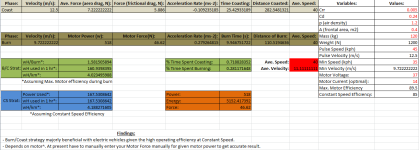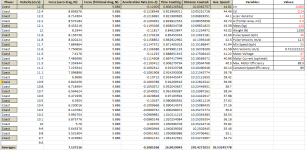CoulombMotorsport
10 mW
Hi all,
So my brother and I are from Perth, Western Australia and we have been building electric endurance vehicles in our garage since 2009 when I was 15 and he was 11. We've now built Australia's most efficient manned land electric vehicle, which achieved 131.7 km/kWh (on a very windy day) and although we're not eligible for the Shell EcoMarathon competition (as we're not an educational institution) we're currently trying to beat the Australasian record of 434 km/kWh.
To try and improve our vehicle's efficiency we're not only improving the vehicle's components but trying to develop a very efficient strategy for the driving of it. One of the most popular fuel saving strategies used by hyper-milers is Coast and Burn (a.k.a Pulse and Glide) but there is very little information currently about it online so I decided to do my own theoretical research to estimate it's effectiveness.
In the following topic, I'm trying to develop a calculator to determine the effectiveness of a Coast and Burn strategy using an excel spreadsheet which takes the following inputs;
- Crr (co-efficient of rolling resistance)
- Cd (co-efficient of aerodynamics)
- Frontal area of the vehicle (m2)
- Mass
- Burn Speed (what speed do you accelerate to?)
- Coast Speed (what speed will you coast down to?)
- Motor Power
and then provide the user with the following information:
- How far will you coast?
- How long will you coast for?
- How far will you burn (pulse) for?
- How long will you burn for?
- Percentage of time spent burning/ percentage of time spent coasting
- wH/km for Burn/Coast Strategy
- wH/km for Constant Speed Strategy
tl;dr Here is the calculator in excel.
View attachment Coast and Burn Calc.xlsx
Time to go back to my Year 12 Physics....
So my brother and I are from Perth, Western Australia and we have been building electric endurance vehicles in our garage since 2009 when I was 15 and he was 11. We've now built Australia's most efficient manned land electric vehicle, which achieved 131.7 km/kWh (on a very windy day) and although we're not eligible for the Shell EcoMarathon competition (as we're not an educational institution) we're currently trying to beat the Australasian record of 434 km/kWh.
To try and improve our vehicle's efficiency we're not only improving the vehicle's components but trying to develop a very efficient strategy for the driving of it. One of the most popular fuel saving strategies used by hyper-milers is Coast and Burn (a.k.a Pulse and Glide) but there is very little information currently about it online so I decided to do my own theoretical research to estimate it's effectiveness.
In the following topic, I'm trying to develop a calculator to determine the effectiveness of a Coast and Burn strategy using an excel spreadsheet which takes the following inputs;
- Crr (co-efficient of rolling resistance)
- Cd (co-efficient of aerodynamics)
- Frontal area of the vehicle (m2)
- Mass
- Burn Speed (what speed do you accelerate to?)
- Coast Speed (what speed will you coast down to?)
- Motor Power
and then provide the user with the following information:
- How far will you coast?
- How long will you coast for?
- How far will you burn (pulse) for?
- How long will you burn for?
- Percentage of time spent burning/ percentage of time spent coasting
- wH/km for Burn/Coast Strategy
- wH/km for Constant Speed Strategy
tl;dr Here is the calculator in excel.
View attachment Coast and Burn Calc.xlsx
Time to go back to my Year 12 Physics....



